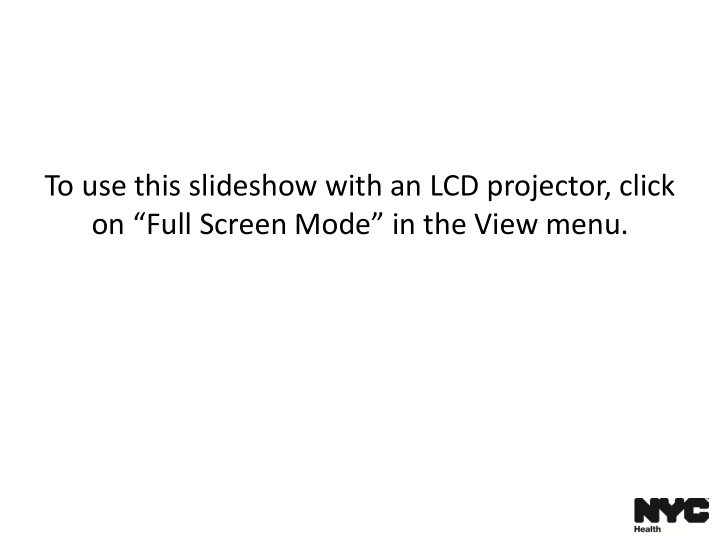



To use this slideshow with an LCD projector, click on “Full Screen Mode” in the View menu.
Obesity is a national problem In New York City, nearly 4 in 10 public school students in grades K ‒ 12 are overweight or obese Source: NHANES; NYC Community Health Survey, 2008; NYC FITNESSGRAM 2009-10
What do children (aged 2 ‒ 18) eat? • Almost half of children’s daily calories are from fat or added sugar • Top three sources of children’s calories are: 1. Sugary drinks (e.g., soda, lemonade) 2. Grain-based desserts 3. Pizza Source: Reedy J, Krebs-Smith S. (2010). Dietary Sources of Energy, Solid Fats, and Added Sugars among Children and Adolescents in the United States. Journal of the American Dietetic Association,110:1477-1484.
Students eat almost half of their daily calories during school hours • Cafeteria • Classroom • Vending machines • School store • Fundraisers Make fundraisers part of the solution instead of the problem! Source: Neumark-Sztainer D, French SA, Hannan PJ, Story M and Fulkerson JA. (2005). School lunch and snacking patterns among high school students: Associations with school food environment and policies. International Journal of Behavioral Nutrition and Physical Activity; 2 :14.
What is wrong with this picture? MyPlate Bake sale Please note that this pictures has been altered to include the Choosemyplate.gov icon.
What is wrong with selling “empty” calories? • They contradict healthy eating messages in schools • They increase the availability of high-fat/ high-sugar foods in schools • They teach students to compromise their health for a profit Sources: Neumark-Sztainer D, French SA, Hannan PJ, Story M and Fulkerson JA. (2005). School lunch and snacking patterns among high school students: Associations with school food environment and policies. International Journal of Behavioral Nutrition and Physical Activity; 2 :14; Contento I, Balch GI, Bronner YL, et al. (1995). Nutrition education for school-aged children. Journal of Nutrition Education; 27(6):298-311.
Why offer fresh fruits and vegetables or non-food fundraisers? • To send clear and consistent healthy eating messages • To help support changes to the school environment – Limit the availability of high-fat/high-sugar foods • To help schools make money and more!
TRUTH: Selling food is NOT the only way to make money Several New York City high schools have successfully implemented non- food fundraisers.
Ideas for fundraiser events • Sports game/tournament • Walk-a-thon • Recycling drive • Donation drive • Student dance, talent show or concert • Flea market • Adult auction
Items to sell • School logo gear • School store items • Flowers or plants • Items at a special event (e.g., glow bracelets at a dance) • Health-related items (e.g., hand sanitizer, mini tissue packs)
If you sell food, think healthy! Fresh produce sold individually or bundled always sends the right health message.
Coordinate fundraisers with holidays, seasons, events September Sell school supply packages October Sell pumpkins for Halloween November Sell produce packages for Thanksgiving December Hold a holiday concert or dance January Hold an indoor event February Sell flowers for Valentine’s Day March Organize a March Madness student-teacher bball game April Organize a walk-a-thon May Sell flowers for Mother’s Day June Sell balloons at graduation
Steps to developing a fundraiser 1. Convene a group of volunteers 2. Evaluate your resources and fundraiser goals 3. Decide what type of fundraiser to hold 4. Plan the fundraiser (who, what, when, where, how) 5. Promote the fundraiser 6. Execute the fundraiser 7. Follow-up and debrief
Regulations pertaining to fundraising • A-610: Fundraising Activities and Collection of Money from Students • A-650: Flea Markets in Schools • A-660: Parent Associations and the Schools • A-812: Competitive Foods • Chancellor’s Regulations: http://schools.nyc.gov/RulesPolicies/ChancellorsRegulations/d efault.htm • New York City Department of Education Wellness Policy: http://schools.nyc.gov/Offices/Health/GenProgServ/Wellness. htm
Just remember, when collecting money from students… • Direct solicitation of money from students during school hours is prohibited • Do not coerce and/or pressure students • Advise students that participation is voluntary • Collect money anonymously in a central repository, e.g., a collection box or jar • See Chancellor’s Regulation A -610 for detailed language
Fundraiser resources New York City Department of Health – A+ Fundraisers for High Schools: http://www.nyc.gov/html/doh/downloads/pdf/cdp/fantastic-fund-hs.pdf – Healthy High Schools Initiative: http://www.nyc.gov/html/doh/html/cdp/cdp-pan-healthy-hs.shtml Other – New York City Fund for Public Schools: http://schools.nyc.gov/FundForPublicSchools/ToolsforSchools/FundraisingTool Kit/default.htm – Healthy Fundraiser Alternatives (California Project Lean): http://www.californiaprojectlean.org/docuserfiles/Ideas%20for%20healthy%2 0fundraising%20fact%20sheet.pdf
Recommend
More recommend